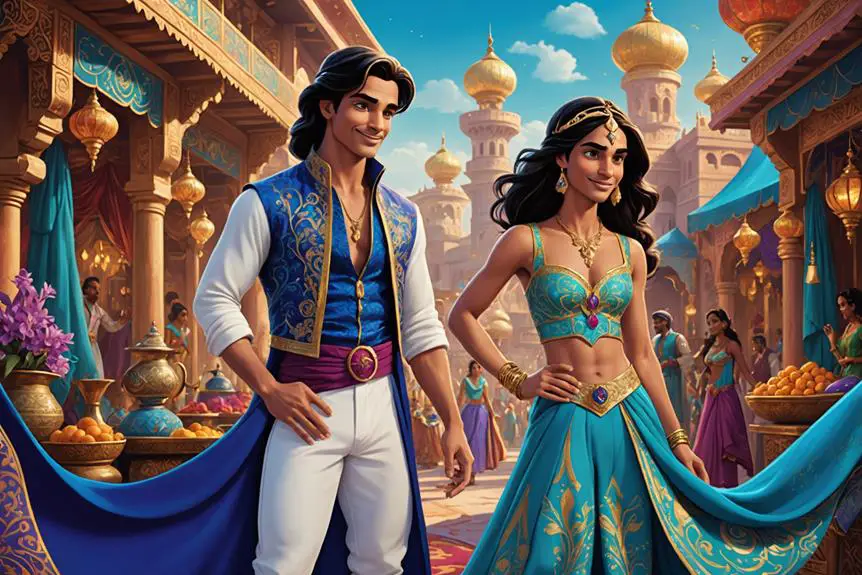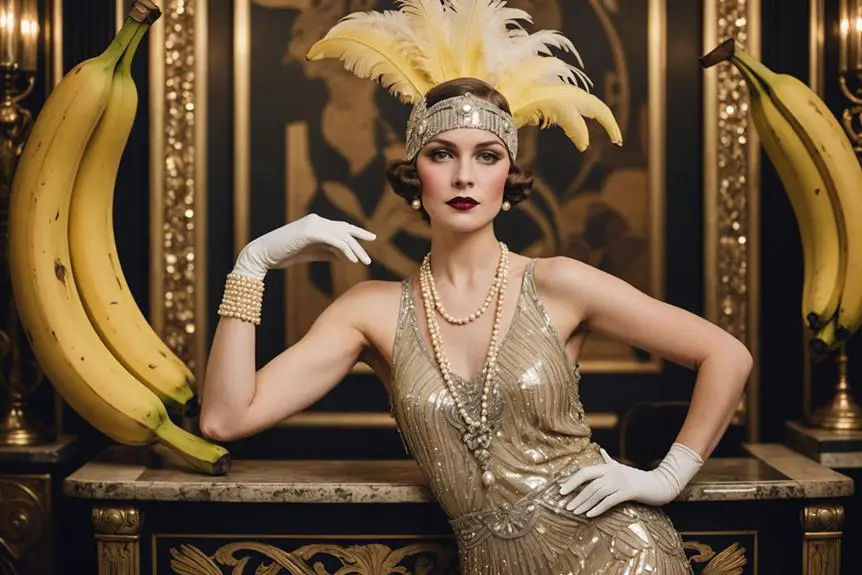When you consider the outfits in "Aladdin" (2019), you can't ignore their role in shaping cultural narratives and sparking discussions around authenticity. Princess Jasmine's array of outfits, rich in South Asian inspiration, certainly aims to challenge traditional portrayals of female characters. Yet, some critiques suggest that the designs might lack the cultural depth they seek. As you explore the intricacies of color, fabric, and character representation, you might find yourself questioning how these choices impact both the narrative and audience perceptions. What does this mean for fashion's role in storytelling?
Cultural Significance of Outfits
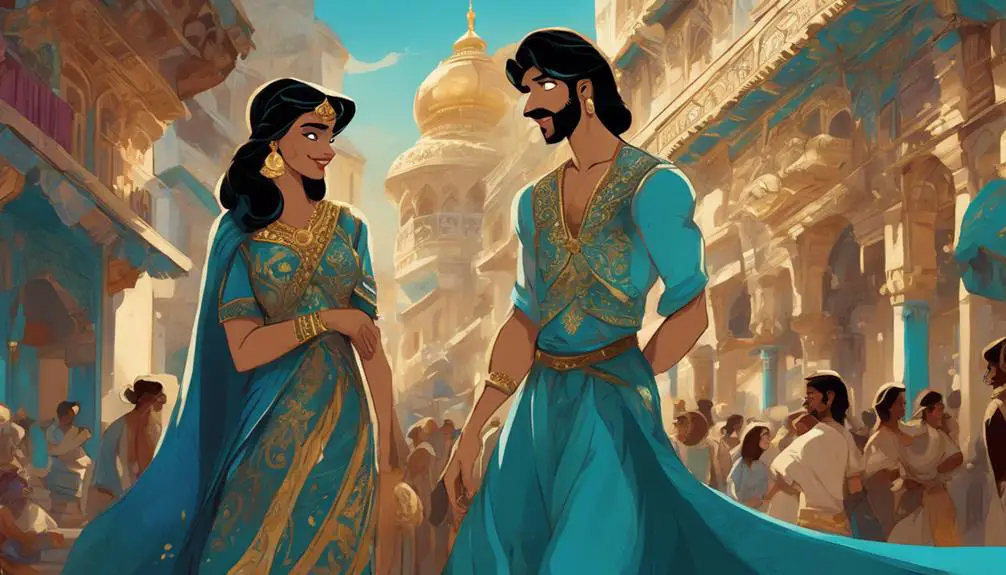
While the costumes in Aladdin (2019) aimed to celebrate Arab culture, they also sparked important conversations about cultural authenticity and representation. You've probably noticed that Jasmine is the first Disney princess with dark hair, right? That's a big deal! It's not just about a pretty face; it's about breaking the mold and showing diverse beauty on screen. With her looks and outfits, Jasmine resonates with so many people.
The costume design took inspiration from The Book of One Thousand and One Nights, blending authentic Middle Eastern references with modern fashion elements. Sounds cool, doesn't it? But here's the twist: some folks thought the costumes missed the mark. They felt like the outfits didn't truly capture the richness of the culture they were trying to represent. It's like when you're trying to show off your favorite dessert, but you just end up with a plain slice of cake instead of the whole fabulous layer cake!
Jasmine's wardrobe changes throughout the film are meant to showcase her confidence and determination. But let's be real, with over ten outfit changes, did it feel a bit like a fashion show? Critics said it seemed superficial, almost like it was trying too hard. So, while the costume design aimed to honor Middle Eastern culture, it also raised questions about how we represent these beautiful traditions. Isn't it important to get it right? After all, every Disney princess deserves a costume that tells her story authentically!
Design Challenges and Critiques
Designing costumes for Aladdin (2019) presented numerous challenges that sparked debate among fans and critics alike. The leap from animated fantasy to live-action realism wasn't easy. You might've noticed that some costumes felt overly polished, especially for characters like Aladdin and Jasmine, who are meant to represent street life. Many fans were disappointed with Jasmine's wardrobe changes, feeling they didn't capture the essence of her original design or cultural significance. What happened to that fierce yet graceful look we all loved?
Then there's Jafar. His character design fell flat, with a turban that looked more like a kid's costume than something a villain would wear. Talk about a missed opportunity! This lack of attention to detail undermined the impact of his character and made it harder for audiences to take him seriously.
Key Color and Fabric Choices
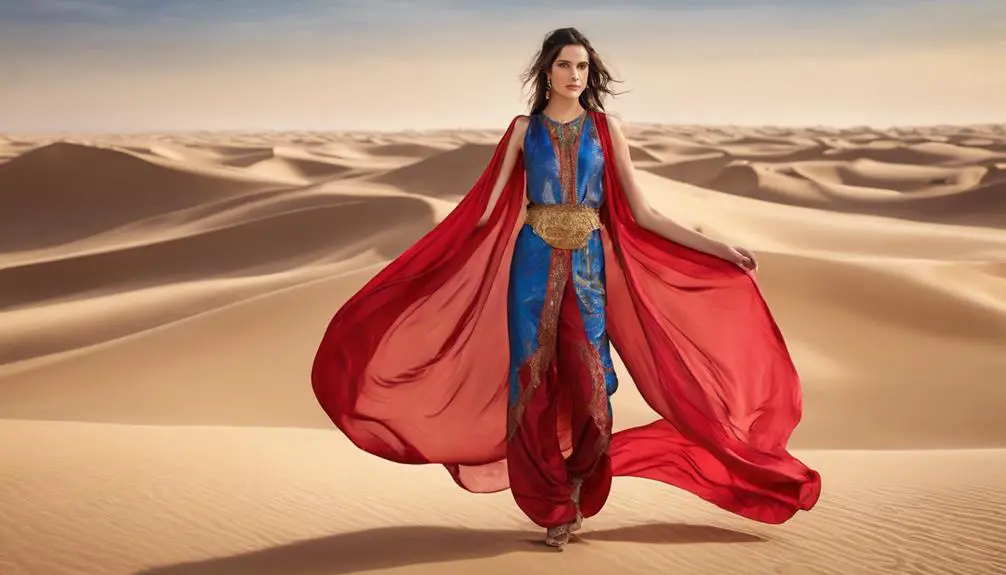
Let's talk about the color and fabric choices in Aladdin's outfits! You might've noticed that Jasmine's new peacock-inspired colors didn't quite mesh together, right? Plus, the silk fabrics were meant to give that authentic Middle Eastern feel, but did they really hit the mark?
Color Palette Analysis
The vibrant color palette in the live-action adaptation of Aladdin showcases a bold departure from Jasmine's traditional turquoise, embracing a range of strong hues and intricate patterns that reflect her dynamic character. You'll notice that the costume designs make a statement, featuring rich jewel tones that pop on screen. This choice doesn't just look good; it's also packed with cultural references that connect Jasmine to her heritage.
But, let's be real—while the colors are striking, some outfits feel a bit disconnected. You might wonder why they didn't stick to a more cohesive design. With so many variations, it's like a colorful jigsaw puzzle that doesn't quite fit together! Plus, the peacock motifs in her jewelry and clothing symbolize her confidence, which is super cool, but they could have been even more luxurious to match her royal status.
In the end, the color palette aims to showcase Jasmine's strength, but it leaves you wishing for a little more harmony and richness. So, what do you think? Does the color make you feel the magic, or does it miss the mark?
Fabric Selection Insights
Costume fabrics play an essential role in bringing Jasmine's character to life in Aladdin (2019). When you think about fabric selection, it's clear that the choice of silk for her costumes aimed to evoke rich Middle Eastern cultural references. The texture was supposed to enhance her outfits, making them feel luxurious and vibrant. However, the live-action adaptation altered Jasmine's original turquoise color scheme, which might've left you feeling a bit disconnected from her character.
You'd also notice the peacock motifs in her jewelry and clothing, which were meant to symbolize her lively spirit. Sadly, the overall execution overshadowed these cultural references, leaving you wondering if they really captured her essence. Variations in color choices throughout the film didn't help either, leading to a lack of cohesive design.
And let's be honest, the budget constraints for the jewelry design made some costumes feel more like props than authentic representations. So, while the costume design aimed high, it missed the mark on cohesiveness and authenticity. Wouldn't it have been amazing to see Jasmine's strong identity really shine through?
Cultural Representation Challenges
Cultural representation in Aladdin (2019) faced significant challenges, particularly in color and fabric choices that aimed to reflect Jasmine's heritage. While the designers tried to incorporate vibrant colors and luxurious fabrics, the final looks often fell short of authenticity. You might have noticed that Jasmine's iconic turquoise was altered, leading to mixed reactions from fans. Did it capture her essence or miss the mark?
- Silk fabrics were used, but the overall design felt disjointed.
- Peacock motifs symbolized Jasmine's vibrant character, yet the costumes looked more like props.
- Critics pointed out the lack of consultation with cultural experts, which hurt the film's authenticity.
These choices led to broader issues of cultural representation in this Disney movie. You can see how it's important to dive deep into the roots of a culture to truly honor it. Instead of feeling like a celebration of Jasmine's rich heritage, the costumes sometimes felt like a missed opportunity. It's a reminder that authenticity matters, especially when telling stories from cultures around the world. Let's hope future adaptations learn from these challenges and do better!
Character-Specific Costume Highlights
Princess Jasmine's vibrant wardrobe captivates viewers with over ten distinct outfits that beautifully reflect her South Asian heritage. Each ensemble is a burst of color, featuring silks, paisley prints, and intricate gold embroidery. You can really feel her confidence and determination shining through her style, don't you think? It's all about showing who she is beyond just a princess.
On the other hand, Aladdin keeps it a bit more straightforward with two main looks. His street rat style, which mixes contemporary street fashion, includes an embroidered band-collared shirt paired with drop-crotch linen trousers. It's practical and stylish, perfect for a guy who needs to be quick on his feet while maneuvering the bustling streets of Agrabah.
Then there's Genie, who takes costume design to a whole new level! His whimsical outfits change as he does, with fabrics from places like India, Turkey, and Morocco. Each outfit adds to his magical vibe, making him one of the most eye-catching characters in the film.
And let's not forget Jafar! His costume design uses a striking red, black, and gold palette, complete with armor-like details that emphasize his villainous nature. You can practically feel the ambition radiating off him!
Even Abu, Aladdin's lovable sidekick, gets a custom-designed monkey costume that's adorable! With a tiny fez and waistcoat, he steals the show, proving that every character has a unique style that adds to the film's charm.
Gender Representation in Costumes
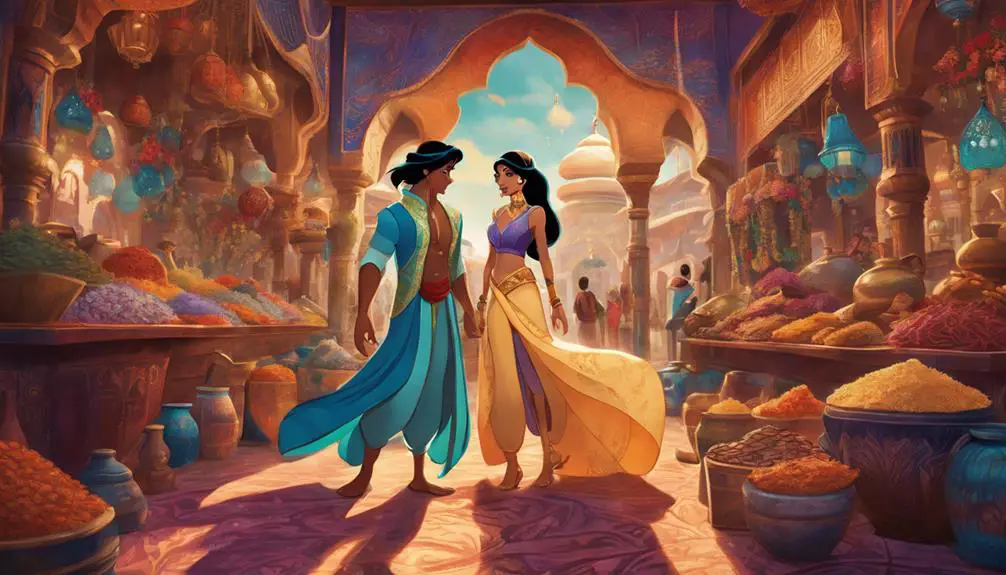
While the vibrant costumes in Aladdin (2019) certainly grab attention, they also raise questions about gender representation in the film. You can't help but notice how Jasmine's outfits dominate the screen, but what does that say about the gender dynamics at play? Let's break it down:
- Jasmine's character shines with over 10 outfit changes, showcasing her confidence and determination. But are these designs really saying something meaningful?
- The decision to tone down her skin exposure compared to the animated version aims to address appropriateness. Still, does it enhance or limit her representation?
- While Jasmine emerges as a strong character, her costumes sometimes miss the mark, lacking authenticity and depth. This can reinforce superficial views of femininity, which isn't ideal.
The costume design puts Jasmine in the spotlight, but at what cost? It tends to overshadow the male characters, leaving them underdeveloped and sidelined. You might find yourself wondering if this focus on her wardrobe detracts from the ensemble cast's storytelling. It's like, are we celebrating a powerful female lead, or merely dressing her up in pretty clothes?
At the end of the day, the film's approach to gender representation through costumes sparks an important conversation. It's vital to reflect on how these choices can influence our views on characters and their stories. So, what do you think? Do the costumes empower or limit?
Audience Reactions to Designs
So, what did you think about the audience reactions to the designs in Aladdin? Many fans weren't thrilled, especially with Jasmine's outfits, feeling they missed the mark on cultural authenticity. It's clear that people wanted costumes that really captured the essence of the characters while staying true to their backgrounds—do you agree?
Mixed Viewer Reactions
Viewer reactions to the costume designs in the 2019 live-action "Aladdin" showcase a striking divide, particularly regarding Jasmine's outfits. Many fans were pretty disappointed, feeling that the costumes didn't capture the character's cultural authenticity or strength. Critics pointed out that Jasmine's wardrobe changes seemed cheap and unoriginal—yikes!
Here's what people had to say:
- Aladdin's attire lacked a lived-in feel, which made him seem less authentic.
- Jasmine's outfits didn't resonate with her strong personality or heritage.
- Will Smith's Genie was praised, but his costumes felt overly polished and unrealistic.
You might wonder how it's possible for a movie about magic and genies to feel so disconnected. Well, those from South Asian backgrounds highlighted that the costume design missed the mark, creating a gap between the characters and their cultural roots. It's a bummer when visuals don't match the story, right? Overall, the mixed feedback suggests that while some elements entertained, the costume design left many feeling a bit let down. After all, costumes can tell powerful stories when done right!
Cultural Authenticity Concerns
Many fans of the 2019 live-action "Aladdin" expressed serious concerns about the cultural authenticity of the costumes, particularly Jasmine's outfits. You might remember how iconic her turquoise look was in the animated movie. Well, a lot of viewers felt that the new designs didn't capture the essence of Middle Eastern culture. Instead, they seemed more like a blend of American fashion with a sprinkle of exotic flair, which didn't sit well with many.
Fans from South Asian backgrounds voiced their disappointment, saying the costumes looked superficial and didn't represent their heritage accurately. Can you imagine how frustrating that must be? They wanted to see deeper research and real cultural consultation in the costume design process. Instead, it felt like a missed opportunity.
Jasmine's wardrobe choices often left people scratching their heads. Critics pointed out that the outfits felt more like a fashion statement than anything authentic. With the lack of cultural consultants, it's no wonder there was a push for a more genuine representation. So, what do you think? Should movies like this take more care in showing cultural authenticity?
Costume Design Critiques
Disappointment permeated audience reactions to the costume designs in the 2019 live-action "Aladdin," particularly regarding Jasmine's attire. Many fans felt her outfits missed the mark on authenticity and didn't connect well with cultural representations. Instead of the beloved blue silk trousers that symbolized her strength and freedom, viewers were left with a mix of styles that felt more like trendy American fashion.
- Critics noted Jasmine's many outfit changes seemed flashy but lacked depth.
- Aladdin's attire appeared too polished, with no signs of wear that would show his streetwise character.
- Jafar's costume was labeled foolish, missing the sinister vibe we expect from a Disney villain.
Fans from South Asian backgrounds especially voiced their concerns, pointing out how Jasmine's looks felt superficial rather than genuinely reflective of her culture. It's hard not to wonder: how could such an iconic character get such a stylish yet disconnected makeover? Ultimately, the costume design didn't just fall flat; it left many fans longing for the authentic charm of the original animated film.
Cultural Inspirations and References
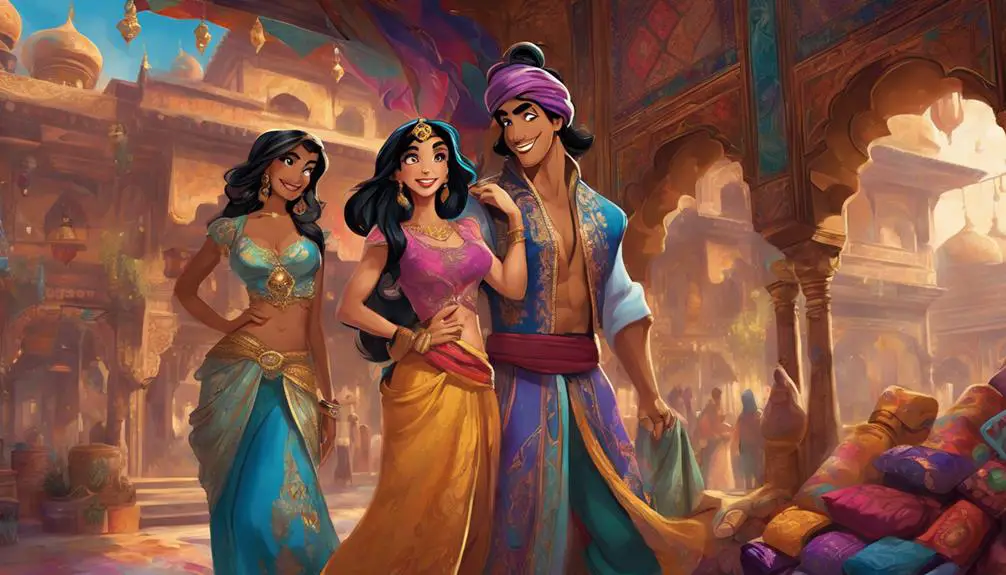
In exploring the cultural inspirations behind the costumes in the 2019 live-action adaptation of Aladdin, you'll find a blend of authentic Middle Eastern influences and modern design elements. Costume designer Michael Wilkinson aimed to bring a fresh take on traditional styles while still honoring cultural authenticity. For example, Jasmine's outfits showcase her South Asian heritage beautifully. With over ten outfit changes, she rocks vibrant silks, paisley prints, and bold colors that really reflect her fiery spirit and desire for freedom.
You might notice that peacock motifs pop up everywhere in Jasmine's jewelry and clothing. Why peacocks, you ask? Well, they symbolize her vibrant character and add a touch of elegance to her wardrobe. The overall costume design tries to mesh historical context with modern storytelling, which is pretty cool! However, despite these efforts, there were some criticisms. People raised concerns about the lack of consultation with cultural experts, which led to some misrepresentation in accessory designs and costume choices.
Can you imagine spending $183 million and still facing questions about cultural representation? That's a lot of cash for costumes that some felt lacked the richness and authenticity typical of traditional styles. So, while the movie's costumes are visually stunning and unique, the conversation around cultural inspirations is definitely worth having. It reminds us how important it is to respect and understand the cultures we portray, don't you think?
Impact on Fashion and Film
The impact of Aladdin's (2019) costume design on fashion and film is undeniable, as it not only captivated audiences but also inspired contemporary designers. With its stunning visuals, the film showcased a vibrant color palette and intricate patterns that brought Middle Eastern influences to the forefront. You can bet that fashion designers are taking notes!
Check out these key takeaways about Aladdin's influence:
- Cultural Representation: The film sparked important conversations about authenticity. Designers are now more mindful of cultural representation, ensuring they avoid cultural appropriation in their work.
- Fashion Trends: Aladdin's costumes, especially those of Jasmine, triggered a resurgence of interest in luxurious fabrics and detailed embroidery. You might just see those styles popping up in your favorite stores!
- Merchandise Inspiration: The character designs don't just stop at the screen. They've inspired a wave of merchandise that blends fantasy with modern fashion, expanding the film's impact into retail.
This film didn't just tell a story; it opened the door for new fashion ideas. The dazzling costume design has encouraged designers to embrace a more diverse and colorful approach, pushing boundaries while celebrating culture. So, the next time you see a bright outfit or intricate embroidery, remember: Aladdin's magic is still alive and well in the fashion world! Isn't that exciting?
Frequently Asked Questions
Who Designed the Costumes for the 2019 "Aladdin" Movie?
The costumes for the 2019 film were designed to reflect character evolution, using vibrant color symbolism and varied fabric choices. You'll notice how each outfit showcases the characters' journeys and emotional states throughout the story.
What Inspired the Modern Fashion Elements in the Outfits?
The modern fashion elements draw from various fashion influences, emphasizing cultural fusion and character representation. You'll notice vibrant colors and patterns reflecting diverse backgrounds, creating a unique blend that resonates with contemporary audiences while honoring tradition.
How Does the Costume Design Differ From the Animated Version?
You'll notice the costume design emphasizes vibrant color palette choices, reflecting each character's identity. It enhances cultural representation, making the characters feel more authentic and relatable, unlike the more simplistic designs of the animated version.
Were Any Real Cultural Consultants Involved in the Costume Design?
Yes, real cultural consultants were involved in the design process, ensuring cultural authenticity. They helped shape costume symbolism, guiding the team to accurately reflect traditions and aesthetics, making the final designs more respectful and representative.
What Awards or Nominations Did the Costume Design Receive?
The costume design received several nominations, highlighting its use of color symbolism, historical fashion influences, and character identity representation. You'll appreciate how these elements enhance the overall storytelling and visual appeal of the production.
